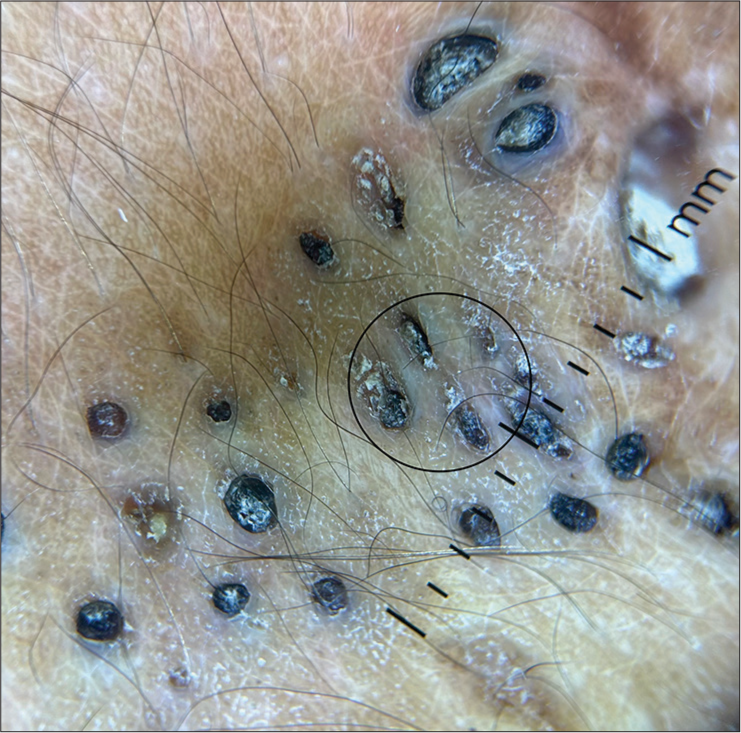Translate this page into:
Nevus comedonicus: Clinical and dermoscopic features

*Corresponding author: Vishal Gaurav, Department of Dermatology and Venereology, Maulana Azad Medical College, New Delhi, India. mevishalgaurav@gmail.com
-
Received: ,
Accepted: ,
How to cite this article: Gaurav V, Patel V, Bahadur A, Barman KD. Nevus comedonicus: Clinical and dermoscopic features. CosmoDerma. 2024;4:74. doi: 10.25259/CSDM_84_2024
A 15-year-old male presented with a cluster of black papules at the back of the left axilla that had been present since birth. Over time, these lesions gradually increased in size and number. The patient reported occasional discharge of keratinous material from the lesions but denied any associated pain or itching. There was no family history of similar skin lesions. On physical examination, multiple comedo-like papules were observed clustered in a linear pattern over the posterior aspect of the left axilla extending to the proximal arm [Figure 1]. The lesions were firm to palpation, non-tender, and not associated with any erythema or inflammation. A dermoscopy of the lesions revealed multiple, closely grouped, and dark brown to black follicular openings filled with keratinous plugs. These plugs were surrounded by a whitish halo, without any vascular structures or inflammatory changes [Figure 2]. Based on clinical and dermoscopic features, the patient was diagnosed with nevus comedonicus (NC). Comedone extraction was carried out and the patient as well as the parents were counseled regarding the benign nature of the disease and the available treatment options.

- Multiple comedo-like papules clustered in a linear pattern over the posterior aspect of the left axilla extending to the proximal arm.

- Non-polarized dermoscopy at ×20 magnification showing multiple, closely grouped, dark brown to black follicular openings filled with keratinous plugs surrounded by a whitish halo (black circle).
The NC is a rare epidermal nevus with clusters of dilated follicular openings filled with keratin, resembling comedones.[1] The occurrence of NC is estimated to range between 1 in 45,000 and 1 in 100,000 individuals, without preference for any specific gender or race. For 50% of those affected, symptoms manifest soon after birth, and most patients exhibit lesions by the age of 10 years.[2] They can occur anywhere on the body, commonly on the face, neck, trunk, and upper arms.[2,3] Dermoscopy is a useful noninvasive tool for its diagnosis, revealing multiple keratin-filled, dilated follicular openings that appear as dark brown to black dots, often surrounded by a white halo.[4] Treatment options include topical retinoids, manual comedone extraction, and surgical interventions such as excision or laser therapy.
Ethical approval
The Institutional Review Board approval is not required.
Declaration of patient consent
The authors certify that they have obtained all appropriate patient consent.
Conflicts of interest
There are no conflicts of interest.
Use of artificial intelligence (AI)-assisted technology for manuscript preparation
The authors confirm that there was no use of artificial intelligence (AI)-assisted technology for assisting in the writing or editing of the manuscript and no images were manipulated using AI.
Financial support and sponsorship
Nil.
References
- Comedones in dermatology. Indian J Dermatol Venereol Leprol. 2024;90:396-407.
- [CrossRef] [PubMed] [Google Scholar]
- Nevus comedonicus: An updated review. Dermatol Ther (Heidelb). 2013;3:33-40.
- [CrossRef] [PubMed] [Google Scholar]






